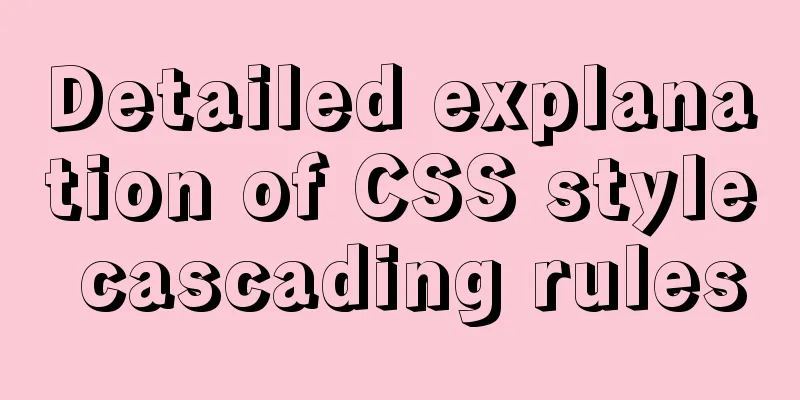Detailed explanation of CSS style cascading rules

|
CSS style rule syntax style is the basic unit of CSS. Each style rule consists of two basic parts: selector and declaration block. The selector determines which elements the style is applied to; The declaration block defines the corresponding style. It is contained in a pair of curly braces and consists of one or more declarations, and each declaration consists of a property and a value separated by a colon. grammar:
1. Find all declarations applied to each element and attribute The browser loads each page. Each CSS rule will be found accordingly, indicating all the affected HTML elements 2. Sort by order and weight The browser checks each of the five origins in turn and sets the properties that match. If the matching attribute is also defined in the next source, update the value of the attribute. 5 sources: 1. Browser default style sheet 2. Setting browser font size to change default style 3. CSS file referenced by link 4. Style code written in style 5. Inline style Declare weight. as follows! important is used to increase the weight of a statement. This way no other sources need to be considered. The order determines the weight. If two rules affect the same property of an element, and they are equally specific, the rule that comes most downstream (or declared later) wins. 3. Sort by specificity: Specificity indicates how clear a rule is. The second rule has both a tag name and a class name so it is more specific. The second rule will override the first rule. Calculating specificity: ICE formula 1. If there is an ID in the selector, add 1 to the position of I; 2. If there is a class in the selector, add 1 to the position of C; 3. If there is an element (tag) name in the selector, add 1 to the position of E; 4. Get a three-digit number. OK, let's use a few examples to explain the specific degree. P 0-0-1 Specificity = 1 p.largetext 0-1-1 specificity=11 p#largetext 1-0-1 specificity=101 body p#largetext 1-0-2 specificity=102 body p#largetext ul.mylist 1-1-3 specificity=113 body p#largetext ul.mylist li 1-1-4 Specificity = 114 Here, each selector is more specific than the previous one. 4. What are the CSS selectors? Which properties are inherited? 1.id selector (#myid) 2. Class selector (.myclassname) 3. Tag selector (div, h1, p) 4. Adjacent Selector (h1 + p) 5. Child selector (ul > li) 6. Descendant selector (li a) 7. Wildcard Selector ( * ) 8. Attribute selector (a[rel = "external"]) 9. Pseudo-class selectors (a:hover, li:nth-child) * Inheritable styles: font-size font-family color, UL LI DL DD DT; * Non-inheritable styles: border padding margin width height; This is the end of this article on the detailed explanation of CSS style cascading rules. For more relevant CSS style cascading content, please search for previous articles on 123WORDPRESS.COM or continue to browse the related articles below. I hope that everyone will support 123WORDPRESS.COM in the future! |
<<: Detailed explanation of pid and socket in MySQL
>>: CSS XTHML writing standards and common problems summary (page optimization)
Recommend
Angular environment construction and simple experience summary
Introduction to Angular Angular is an open source...
Vue implements automatic jump to login page when token expires
The project was tested these days, and the tester...
Detailed explanation of how to use Teleport, a built-in component of Vue3
Table of contents 1. Teleport usage 2. Complete t...
Brief analysis of centos 7 mysql-8.0.19-1.el7.x86_64.rpm-bundle.tar
Baidu Cloud Disk: Link: https://pan.baidu.com/s/1...
HTML insert image example (html add image)
Inserting images into HTML requires HTML tags to ...
How to build a private Docker repository using Harbor
Table of contents 1. Open source warehouse manage...
CSS realizes corner cutting + border + projection + content background color gradient effect
Simply use CSS to achieve all the effects of corn...
Detailed explanation of importing/exporting MySQL data in Docker container
Preface We all know that the import and export of...
JavaScript to show and hide images
JavaScript shows and hides pictures, for your ref...
Specific use of ES6 array copy and fill methods copyWithin() and fill()
Table of contents Batch copy copyWithin() Fill ar...
MySQL 5.7.17 winx64 installation and configuration graphic tutorial
I summarized the previous notes on installing MyS...
How to simulate network packet loss and delay in Linux
netem and tc: netem is a network simulation modul...
How to modify the user and group of a file in Linux
In Linux, when a file is created, the owner of th...
JavaScript destructuring assignment detailed explanation
Table of contents concept Array Destructuring Dec...
New ideas for time formatting in JavaScript toLocaleString()
Table of contents 1. Conventional ideas for time ...









